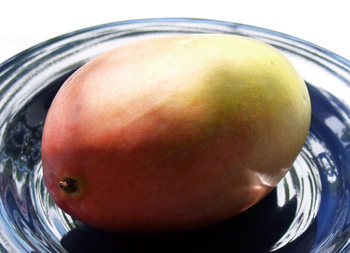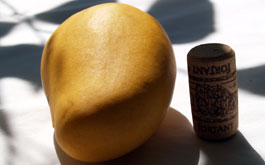 Mango (Tommy Atkin variety)
Mango (Tommy Atkin variety)© Denzil Green
The Manila variety has yellow skin, the Tommy Atkins variety has red and green skin, the Haden variety has yellow and pink skin, and the Keitt variety has green skin. The skin on all varieties is inedible.
Inside, the fruit has golden flesh and a large stone in the middle. It has a sweet taste with a bit of tartness that adds a tang.
Mangos are picked and shipped before they are fully ripe. They will arrive at the store firm, but not hard.
Really hard ones probably won’t ripen for you at home, just rot. These will have a sour taste, and are meant for cooking, not for eating raw. They are used in Thai recipes and in some Indian dishes.
Mango is a very important product of India. In India, the “alphonso” variety is the first each year to come into season.
When buying Mango to eat out of hand, choose ones that are slightly scented and have a bit of give when pressed. There should be no wrinkles or blemishes. Small black dots on the skin are normal. The colour of the skin should seem fully developed and you should be able to smell the fruit around the stem end.
Wood from mango trees burns very well, even when green.
Cooking Tips
Cut around the large seed in the middle, then peel the rest.
To make cubes, separate the two halves. Make horizontal then vertical cuts in the flesh, not cutting through the skin. If you want to make a Mango porcupine after cubing it, push the skin side up and pull the flesh side down. Otherwise, at this point, just use a knife to sever the cubes off.
Nutrition
Good source of vitamins A and C.
The skin of the Mango may be an irritant to some people (Mango belongs to the same family as poison ivy and poison oak).
Equivalents
½ cup fresh, peeled Mango = 3 oz / 85g
4 slices fresh, peeled Mango = 2 oz / 50g
Storage Hints
Mango (Manila variety)
– © Denzil Green
Mangos are shipped unripe. To ripen one, wrap it in paper, put in a bowl, cover bowl with paper and allow to sit at room temperature.
When ripe, store in refrigerator and use within 2 to 4 days.
History Notes
Mangos are native to South-East Asia. They were being cultivated in India back in 2000 BC. The Portuguese introduced them to Africa in the 1500s. From there, they were brought to Brazil and the Caribbean in the 1700s, and in the 1800s to Mexico and Florida. Brought to Hawaii in 1842.
The Keitt variety was developed in Florida.
Literature & Lore
Both “Mangos” and “Mangoes” are correct as the plural.
Sources
Parle, Stevie. Mangoes: Golden glories of an Indian spring. London: Daily Telegraph. 30 April 2011.


